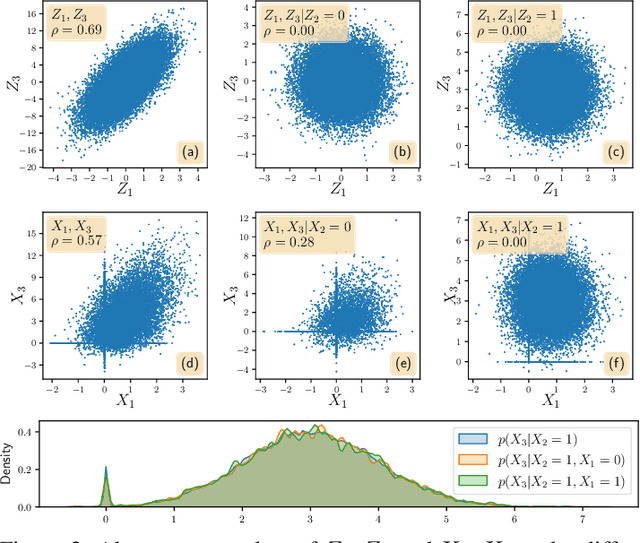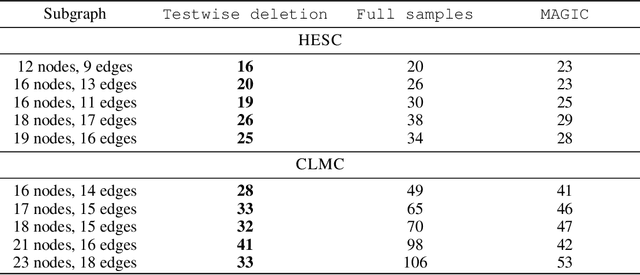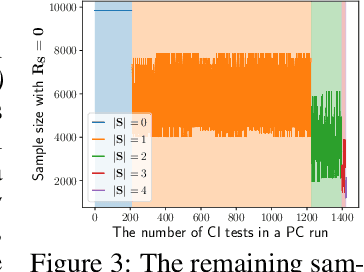Peter Spirtes
Score-based Greedy Search for Structure Identification of Partially Observed Linear Causal Models
Oct 05, 2025Abstract:Identifying the structure of a partially observed causal system is essential to various scientific fields. Recent advances have focused on constraint-based causal discovery to solve this problem, and yet in practice these methods often face challenges related to multiple testing and error propagation. These issues could be mitigated by a score-based method and thus it has raised great attention whether there exists a score-based greedy search method that can handle the partially observed scenario. In this work, we propose the first score-based greedy search method for the identification of structure involving latent variables with identifiability guarantees. Specifically, we propose Generalized N Factor Model and establish the global consistency: the true structure including latent variables can be identified up to the Markov equivalence class by using score. We then design Latent variable Greedy Equivalence Search (LGES), a greedy search algorithm for this class of model with well-defined operators, which search very efficiently over the graph space to find the optimal structure. Our experiments on both synthetic and real-life data validate the effectiveness of our method (code will be publicly available).
Algorithmic Fairness amid Social Determinants: Reflection, Characterization, and Approach
Aug 10, 2025



Abstract:Social determinants are variables that, while not directly pertaining to any specific individual, capture key aspects of contexts and environments that have direct causal influences on certain attributes of an individual. Previous algorithmic fairness literature has primarily focused on sensitive attributes, often overlooking the role of social determinants. Our paper addresses this gap by introducing formal and quantitative rigor into a space that has been shaped largely by qualitative proposals regarding the use of social determinants. To demonstrate theoretical perspectives and practical applicability, we examine a concrete setting of college admissions, using region as a proxy for social determinants. Our approach leverages a region-based analysis with Gamma distribution parameterization to model how social determinants impact individual outcomes. Despite its simplicity, our method quantitatively recovers findings that resonate with nuanced insights in previous qualitative debates, that are often missed by existing algorithmic fairness approaches. Our findings suggest that mitigation strategies centering solely around sensitive attributes may introduce new structural injustice when addressing existing discrimination. Considering both sensitive attributes and social determinants facilitates a more comprehensive explication of benefits and burdens experienced by individuals from diverse demographic backgrounds as well as contextual environments, which is essential for understanding and achieving fairness effectively and transparently.
Causal Discovery and Counterfactual Reasoning to Optimize Persuasive Dialogue Policies
Mar 19, 2025Abstract:Tailoring persuasive conversations to users leads to more effective persuasion. However, existing dialogue systems often struggle to adapt to dynamically evolving user states. This paper presents a novel method that leverages causal discovery and counterfactual reasoning for optimizing system persuasion capability and outcomes. We employ the Greedy Relaxation of the Sparsest Permutation (GRaSP) algorithm to identify causal relationships between user and system utterance strategies, treating user strategies as states and system strategies as actions. GRaSP identifies user strategies as causal factors influencing system responses, which inform Bidirectional Conditional Generative Adversarial Networks (BiCoGAN) in generating counterfactual utterances for the system. Subsequently, we use the Dueling Double Deep Q-Network (D3QN) model to utilize counterfactual data to determine the best policy for selecting system utterances. Our experiments with the PersuasionForGood dataset show measurable improvements in persuasion outcomes using our approach over baseline methods. The observed increase in cumulative rewards and Q-values highlights the effectiveness of causal discovery in enhancing counterfactual reasoning and optimizing reinforcement learning policies for online dialogue systems.
When Selection Meets Intervention: Additional Complexities in Causal Discovery
Mar 10, 2025Abstract:We address the common yet often-overlooked selection bias in interventional studies, where subjects are selectively enrolled into experiments. For instance, participants in a drug trial are usually patients of the relevant disease; A/B tests on mobile applications target existing users only, and gene perturbation studies typically focus on specific cell types, such as cancer cells. Ignoring this bias leads to incorrect causal discovery results. Even when recognized, the existing paradigm for interventional causal discovery still fails to address it. This is because subtle differences in when and where interventions happen can lead to significantly different statistical patterns. We capture this dynamic by introducing a graphical model that explicitly accounts for both the observed world (where interventions are applied) and the counterfactual world (where selection occurs while interventions have not been applied). We characterize the Markov property of the model, and propose a provably sound algorithm to identify causal relations as well as selection mechanisms up to the equivalence class, from data with soft interventions and unknown targets. Through synthetic and real-world experiments, we demonstrate that our algorithm effectively identifies true causal relations despite the presence of selection bias.
* Appears at ICLR 2025 (oral)
Reflection-Window Decoding: Text Generation with Selective Refinement
Feb 05, 2025



Abstract:The autoregressive decoding for text generation in large language models (LLMs), while widely used, is inherently suboptimal due to the lack of a built-in mechanism to perform refinement and/or correction of the generated content. In this paper, we consider optimality in terms of the joint probability over the generated response, when jointly considering all tokens at the same time. We theoretically characterize the potential deviation of the autoregressively generated response from its globally optimal counterpart that is of the same length. Our analysis suggests that we need to be cautious when noticeable uncertainty arises during text generation, which may signal the sub-optimality of the generation history. To address the pitfall of autoregressive decoding for text generation, we propose an approach that incorporates a sliding reflection window and a pausing criterion, such that refinement and generation can be carried out interchangeably as the decoding proceeds. Our selective refinement framework strikes a balance between efficiency and optimality, and our extensive experimental results demonstrate the effectiveness of our approach.
Permutation-Based Rank Test in the Presence of Discretization and Application in Causal Discovery with Mixed Data
Jan 31, 2025



Abstract:Recent advances have shown that statistical tests for the rank of cross-covariance matrices play an important role in causal discovery. These rank tests include partial correlation tests as special cases and provide further graphical information about latent variables. Existing rank tests typically assume that all the continuous variables can be perfectly measured, and yet, in practice many variables can only be measured after discretization. For example, in psychometric studies, the continuous level of certain personality dimensions of a person can only be measured after being discretized into order-preserving options such as disagree, neutral, and agree. Motivated by this, we propose Mixed data Permutation-based Rank Test (MPRT), which properly controls the statistical errors even when some or all variables are discretized. Theoretically, we establish the exchangeability and estimate the asymptotic null distribution by permutations; as a consequence, MPRT can effectively control the Type I error in the presence of discretization while previous methods cannot. Empirically, our method is validated by extensive experiments on synthetic data and real-world data to demonstrate its effectiveness as well as applicability in causal discovery.
Choosing DAG Models Using Markov and Minimal Edge Count in the Absence of Ground Truth
Sep 30, 2024Abstract:We give a novel nonparametric pointwise consistent statistical test (the Markov Checker) of the Markov condition for directed acyclic graph (DAG) or completed partially directed acyclic graph (CPDAG) models given a dataset. We also introduce the Cross-Algorithm Frugality Search (CAFS) for rejecting DAG models that either do not pass the Markov Checker test or that are not edge minimal. Edge minimality has been used previously by Raskutti and Uhler as a nonparametric simplicity criterion, though CAFS readily generalizes to other simplicity conditions. Reference to the ground truth is not necessary for CAFS, so it is useful for finding causal structure learning algorithms and tuning parameter settings that output causal models that are approximately true from a given data set. We provide a software tool for this analysis that is suitable for even quite large or dense models, provided a suitably fast pointwise consistent test of conditional independence is available. In addition, we show in simulation that the CAFS procedure can pick approximately correct models without knowing the ground truth.
On the Parameter Identifiability of Partially Observed Linear Causal Models
Jul 24, 2024



Abstract:Linear causal models are important tools for modeling causal dependencies and yet in practice, only a subset of the variables can be observed. In this paper, we examine the parameter identifiability of these models by investigating whether the edge coefficients can be recovered given the causal structure and partially observed data. Our setting is more general than that of prior research - we allow all variables, including both observed and latent ones, to be flexibly related, and we consider the coefficients of all edges, whereas most existing works focus only on the edges between observed variables. Theoretically, we identify three types of indeterminacy for the parameters in partially observed linear causal models. We then provide graphical conditions that are sufficient for all parameters to be identifiable and show that some of them are provably necessary. Methodologically, we propose a novel likelihood-based parameter estimation method that addresses the variance indeterminacy of latent variables in a specific way and can asymptotically recover the underlying parameters up to trivial indeterminacy. Empirical studies on both synthetic and real-world datasets validate our identifiability theory and the effectiveness of the proposed method in the finite-sample regime.
Counterfactual Reasoning Using Predicted Latent Personality Dimensions for Optimizing Persuasion Outcome
Apr 21, 2024Abstract:Customizing persuasive conversations related to the outcome of interest for specific users achieves better persuasion results. However, existing persuasive conversation systems rely on persuasive strategies and encounter challenges in dynamically adjusting dialogues to suit the evolving states of individual users during interactions. This limitation restricts the system's ability to deliver flexible or dynamic conversations and achieve suboptimal persuasion outcomes. In this paper, we present a novel approach that tracks a user's latent personality dimensions (LPDs) during ongoing persuasion conversation and generates tailored counterfactual utterances based on these LPDs to optimize the overall persuasion outcome. In particular, our proposed method leverages a Bi-directional Generative Adversarial Network (BiCoGAN) in tandem with a Dialogue-based Personality Prediction Regression (DPPR) model to generate counterfactual data. This enables the system to formulate alternative persuasive utterances that are more suited to the user. Subsequently, we utilize the D3QN model to learn policies for optimized selection of system utterances on counterfactual data. Experimental results we obtained from using the PersuasionForGood dataset demonstrate the superiority of our approach over the existing method, BiCoGAN. The cumulative rewards and Q-values produced by our method surpass ground truth benchmarks, showcasing the efficacy of employing counterfactual reasoning and LPDs to optimize reinforcement learning policy in online interactions.
Gene Regulatory Network Inference in the Presence of Dropouts: a Causal View
Mar 21, 2024



Abstract:Gene regulatory network inference (GRNI) is a challenging problem, particularly owing to the presence of zeros in single-cell RNA sequencing data: some are biological zeros representing no gene expression, while some others are technical zeros arising from the sequencing procedure (aka dropouts), which may bias GRNI by distorting the joint distribution of the measured gene expressions. Existing approaches typically handle dropout error via imputation, which may introduce spurious relations as the true joint distribution is generally unidentifiable. To tackle this issue, we introduce a causal graphical model to characterize the dropout mechanism, namely, Causal Dropout Model. We provide a simple yet effective theoretical result: interestingly, the conditional independence (CI) relations in the data with dropouts, after deleting the samples with zero values (regardless if technical or not) for the conditioned variables, are asymptotically identical to the CI relations in the original data without dropouts. This particular test-wise deletion procedure, in which we perform CI tests on the samples without zeros for the conditioned variables, can be seamlessly integrated with existing structure learning approaches including constraint-based and greedy score-based methods, thus giving rise to a principled framework for GRNI in the presence of dropouts. We further show that the causal dropout model can be validated from data, and many existing statistical models to handle dropouts fit into our model as specific parametric instances. Empirical evaluation on synthetic, curated, and real-world experimental transcriptomic data comprehensively demonstrate the efficacy of our method.
 Add to Chrome
Add to Chrome Add to Firefox
Add to Firefox Add to Edge
Add to Edge